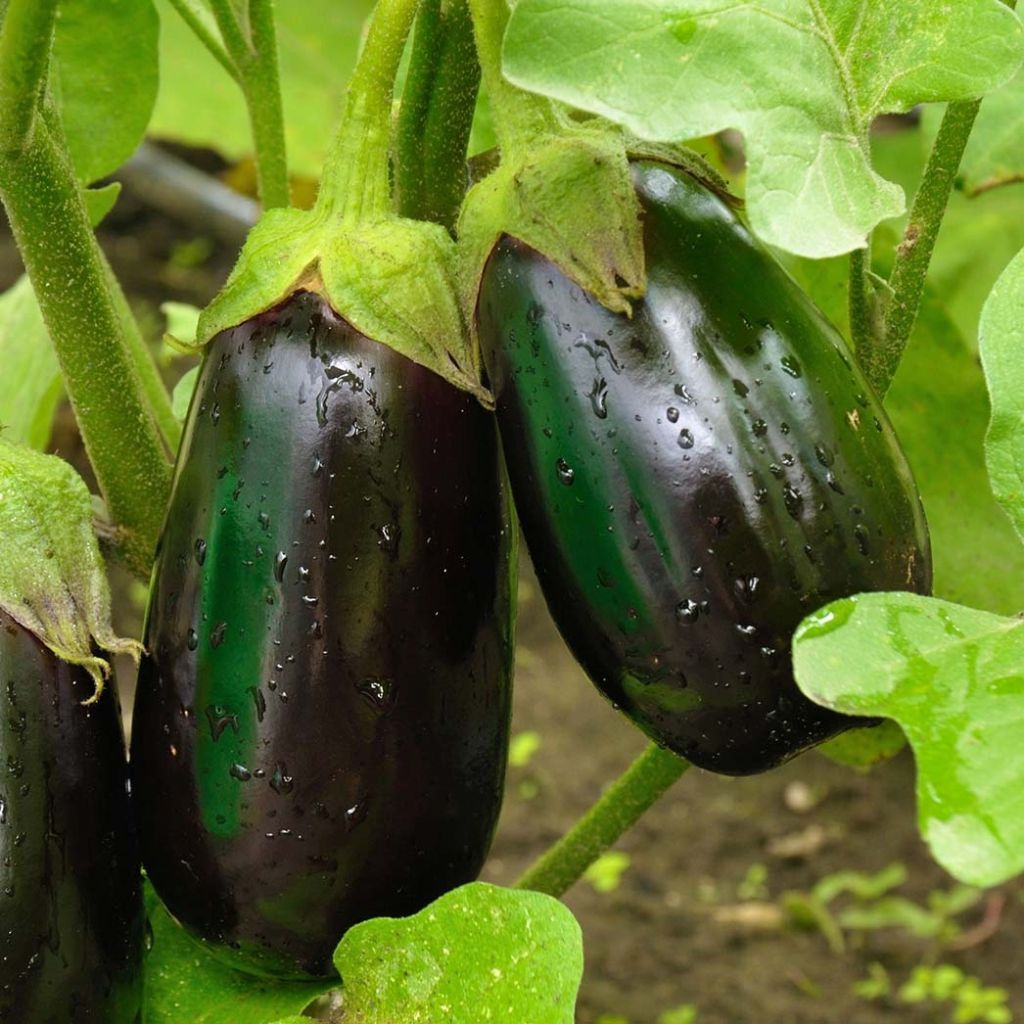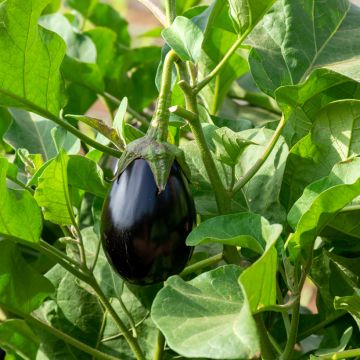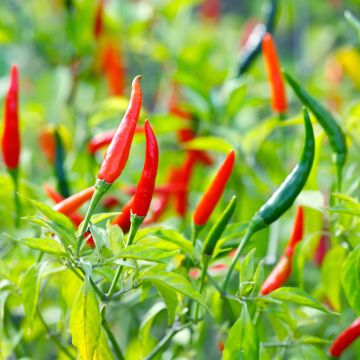

Aubergine Bonica F1 Seedlings
Aubergine Bonica F1 Seedlings
Solanum melongena Bonica F1
Aubergine, Eggplant
This item cannot be shipped to the selected country
Delivery charge from €5.90
Delivery charge from €5.90
Delivery charge from €5.90
More information
Schedule delivery date,
and select date in basket
This plant carries a 6 months recovery warranty
More information
We guarantee the quality of our plants for a full growing cycle, and will replace at our expense any plant that fails to recover under normal climatic and planting conditions.
From €5.90 for pickup delivery and €6.90 for home delivery
Express home delivery from €8.90.
From €5.90 for pickup delivery and €6.90 for home delivery
Express home delivery from €8.90.
From €5.90 for pickup delivery and €6.90 for home delivery
Express home delivery from €8.90.
Description
The 'Bonica' F1 eggplant is an early, vigorous and productive variety. Its fruits are ovate, about 13 to 15 cm (5 to 6in) long and dark purple in colour. They are consumed cooked, alone or in ratatouilles, tians, gratins, stuffed etc. This variety has good disease resistance. Eggplant is a heat-loving plant and is grown as an annual in our latitudes. The young plants of 'Bonica' eggplant are planted from April to June, after the last frost. Harvesting takes place from July to October.
Eggplant belongs to the Solanaceae family, like tomato, pepper and potato. This plant, perennial in warm countries, is grown as an annual in our climate. It has ovate, hairy leaves and offers small purple flowers from June to September. Depending on the varieties, eggplants can be round or long and come in different colours: from black-purple to white, and even yellow, sometimes with a uniform color, sometimes striated. A beautiful diversity to discover!
In the vegetable garden, this sun-loving vegetable needs heat to grow. It will appreciate the presence of flowers to attract insects and promote pollination.
Harvesting: pick the fruits with pruning shears, from August to October (or from July for early varieties). The fruits are harvested slightly before ripeness.
Storage: Eggplants should be consumed quickly and can be kept for a few days in the lower part of the refrigerator.
Gardener's tip: We recommend mulching the soil with thin successive layers of grass clippings, if possible mixed with dead leaves. This protection, which keeps the soil moist, also limits weed growth. You can also opt for a mineral mulch (bricks, slates etc) which will help accumulate heat.
Note: Our young plug plants are professional products reserved for experienced gardeners: upon receipt, transplant and store them in sheltered areas (veranda, greenhouse, cold frame) at a temperature above 14°C (57.2°F) for a few weeks before being installed outdoors once the risk of frost has definitively passed.
Report an error about the product description
Harvest
Plant habit
Foliage
Other Eggplant plants
Planting and care
Planting:
Grow the plants by transplanting them into trays or pots measuring 8 to 13 cm (3 to 5in) in diameter, filled with compost. Attention: When transplanting grafted plants, do not bury the graft point! Place the plants in a warm and bright location. Water regularly.
Planting in the ground should be done around mid-May or in June, when the risk of frost has passed. Plant the Aubergine in full sun, in a sheltered spot. It thrives in well-drained and fertile soil. As the aubergine is a demanding vegetable, it will be necessary to add well-rotted compost in the previous autumn. In cooler regions, it is advisable to plant the aubergine in a greenhouse.
Soak the root ball in water for a few moments before planting. Space the plants 50 cm (20in) apart in all directions. Dig a hole, place your plant with the graft point at ground level, then cover with fine soil. Water thoroughly.
At the beginning of the season, protect the plants with a mini-tunnel or a frame to gain a few degrees.
The aubergine can also be grown in a pot, provided it is placed in the sun. In this case, you can plant the plug plants directly into the pot.
Maintenance:
Regularly hoe and weed. Remove the suckers that develop at the base of the plant.
Water regularly, taking care not to wet the foliage to prevent the appearance of fungal diseases such as mildew. Drip irrigation is well suited.
Pruning will be necessary to promote fruit development. In July, cut the main stem above the 2nd flower. Repeat this operation on the new shoots that develop. This way, you can expect to harvest an average of 7 to 8 fruits per plant.
Diseases and pests:
The Aubergine is susceptible, just like the tomato, to mildew. This is a fungal disease caused by the Phytophthora infestans fungus. Mildew develops in hot and humid weather. Small spots appear, white on the undersides of the leaves and green-grey on top. To limit the risks, space the plants sufficiently and avoid watering the foliage. In terms of rotation, wait 4 years before growing a plant from the Solanaceae family in the same location and do not grow them in neighbouring rows. If necessary, spray Bordeaux mixture or preparations such as horsetail decoction or garlic spray.
Harvest can also be disrupted by the Colorado potato beetle, an insect of the order Coleoptera. You will recognise it by its yellow head and its yellow and black striped body. The best solution, although a bit time-consuming, is to remove them as they appear. As a preventive measure, sow blue flax seeds between your rows of Aubergines. Sow from April to June in shallow furrows. In addition to its repellent effect against Colorado potato beetles, flax will brighten up your vegetable garden with its pretty little blue flowers.
Finally, you can protect young plants from slugs and snails by placing ash or coffee grounds nearby, to be renewed after rain.
Cultivation
Care
Intended location
-
, onOrder confirmed
Reply from on Promesse de fleurs
Vegetable plants
Haven't found what you were looking for?
Hardiness is the lowest winter temperature a plant can endure without suffering serious damage or even dying. However, hardiness is affected by location (a sheltered area, such as a patio), protection (winter cover) and soil type (hardiness is improved by well-drained soil).

Photo Sharing Terms & Conditions
In order to encourage gardeners to interact and share their experiences, Promesse de fleurs offers various media enabling content to be uploaded onto its Site - in particular via the ‘Photo sharing’ module.
The User agrees to refrain from:
- Posting any content that is illegal, prejudicial, insulting, racist, inciteful to hatred, revisionist, contrary to public decency, that infringes on privacy or on the privacy rights of third parties, in particular the publicity rights of persons and goods, intellectual property rights, or the right to privacy.
- Submitting content on behalf of a third party;
- Impersonate the identity of a third party and/or publish any personal information about a third party;
In general, the User undertakes to refrain from any unethical behaviour.
All Content (in particular text, comments, files, images, photos, videos, creative works, etc.), which may be subject to property or intellectual property rights, image or other private rights, shall remain the property of the User, subject to the limited rights granted by the terms of the licence granted by Promesse de fleurs as stated below. Users are at liberty to publish or not to publish such Content on the Site, notably via the ‘Photo Sharing’ facility, and accept that this Content shall be made public and freely accessible, notably on the Internet.
Users further acknowledge, undertake to have ,and guarantee that they hold all necessary rights and permissions to publish such material on the Site, in particular with regard to the legislation in force pertaining to any privacy, property, intellectual property, image, or contractual rights, or rights of any other nature. By publishing such Content on the Site, Users acknowledge accepting full liability as publishers of the Content within the meaning of the law, and grant Promesse de fleurs, free of charge, an inclusive, worldwide licence for the said Content for the entire duration of its publication, including all reproduction, representation, up/downloading, displaying, performing, transmission, and storage rights.
Users also grant permission for their name to be linked to the Content and accept that this link may not always be made available.
By engaging in posting material, Users consent to their Content becoming automatically accessible on the Internet, in particular on other sites and/or blogs and/or web pages of the Promesse de fleurs site, including in particular social pages and the Promesse de fleurs catalogue.
Users may secure the removal of entrusted content free of charge by issuing a simple request via our contact form.
The flowering period indicated on our website applies to countries and regions located in USDA zone 8 (France, the United Kingdom, Ireland, the Netherlands, etc.)
It will vary according to where you live:
- In zones 9 to 10 (Italy, Spain, Greece, etc.), flowering will occur about 2 to 4 weeks earlier.
- In zones 6 to 7 (Germany, Poland, Slovenia, and lower mountainous regions), flowering will be delayed by 2 to 3 weeks.
- In zone 5 (Central Europe, Scandinavia), blooming will be delayed by 3 to 5 weeks.
In temperate climates, pruning of spring-flowering shrubs (forsythia, spireas, etc.) should be done just after flowering.
Pruning of summer-flowering shrubs (Indian Lilac, Perovskia, etc.) can be done in winter or spring.
In cold regions as well as with frost-sensitive plants, avoid pruning too early when severe frosts may still occur.
The planting period indicated on our website applies to countries and regions located in USDA zone 8 (France, United Kingdom, Ireland, Netherlands).
It will vary according to where you live:
- In Mediterranean zones (Marseille, Madrid, Milan, etc.), autumn and winter are the best planting periods.
- In continental zones (Strasbourg, Munich, Vienna, etc.), delay planting by 2 to 3 weeks in spring and bring it forward by 2 to 4 weeks in autumn.
- In mountainous regions (the Alps, Pyrenees, Carpathians, etc.), it is best to plant in late spring (May-June) or late summer (August-September).
The harvesting period indicated on our website applies to countries and regions in USDA zone 8 (France, England, Ireland, the Netherlands).
In colder areas (Scandinavia, Poland, Austria...) fruit and vegetable harvests are likely to be delayed by 3-4 weeks.
In warmer areas (Italy, Spain, Greece, etc.), harvesting will probably take place earlier, depending on weather conditions.
The sowing periods indicated on our website apply to countries and regions within USDA Zone 8 (France, UK, Ireland, Netherlands).
In colder areas (Scandinavia, Poland, Austria...), delay any outdoor sowing by 3-4 weeks, or sow under glass.
In warmer climes (Italy, Spain, Greece, etc.), bring outdoor sowing forward by a few weeks.




















































